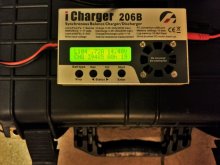Mike Jordan
Solar Enthusiast
- Joined
- Jun 15, 2020
- Messages
- 414
I have been searching the interwebs for a good solar charging solution for the odd voltages of 4s and 5s 18650 Li-Ion packs. Suddenly I had an epiphany... or a very bad idea. Thats where a solar gawd/RC enthusiast would help
I have a 120w portable panel. The manufacturer rates the Voc at 19v. I measured it at 19.9v cloudy, 22.7v sunny.
I have an iCharger 206b (link for specs) which will charge my batts connected to a power supply rated 10-28v.
Can I connect my iCharger 206b to my solar panel, to crate a solar charge controller, to charge my batts?

I have a 120w portable panel. The manufacturer rates the Voc at 19v. I measured it at 19.9v cloudy, 22.7v sunny.
I have an iCharger 206b (link for specs) which will charge my batts connected to a power supply rated 10-28v.
Can I connect my iCharger 206b to my solar panel, to crate a solar charge controller, to charge my batts?



